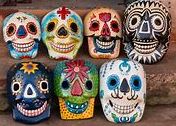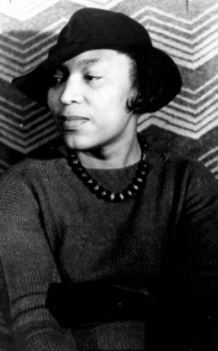I gave this talk nearly 31 years ago at a professional psychology conference, where I urged minorities to keep wearing masks. For more detail and context, read the introduction to PART 1 of the talk. Part 1 ended with James Baldwin’s assertion that Uncle Tom and Aunt Jemima—two figures usually looked down upon by what today we might call “woke” people—had a power and significance we need to reassess. Part 2 below begins by explaining why such reassessment is so crucial, not only when James Baldwin wrote about it in the 1950’s, but even more so today.
Uncle Tom and Aunt Jemima represent those people who, as Baldwin says,
“…smile, who go to church, who give no cause for complaint, whom we sometimes consider with amusement, with pity, even with affection–and in whose faces we sometimes surprise the merest arrogant hint of hatred, the faintest withdrawn, speculative shadow of contempt—who make us uneasy…It is out of our reaction to these hewers of wood and drawers of water that our image of Bigger was created.” Again, it is them we really fear, not Bigger.
Baldwin’s insight is that the image of Bigger Thomas, one which Richard Wright may have believed himself, is created out of the fear and compulsive desires of white society, but that image also lives inside the African-American heart. Here, I think, are the most important passages of his essay:
“…there is, I should think, no Negro living in America who has not felt, briefly or for long periods, with anguish sharp or dull, in varying degrees and to varying effect, simple, naked and unanswerable hatred; who has not wanted to smash any white face he may encounter in a day, to violate, out of motives of cruelest vengeance, their women, to break the bodies of all white people and bring them low, as low as that dust into which he himself has been and is being trampled; no Negro, finally, who has not had to make his own precarious adjustment to the ‘nigger’ who surrounds him and to the ‘nigger’ in himself.” (30)
Baldwin does not believe Native Son conveys “the altogether savage paradox of the American Negro’s situation.” “If, as I believe,” he says,
“…no American Negro exists who does not have his private Bigger Thomas living in the skull, then what most significantly fails to be illuminated here is the paradoxical adjustment which is perpetually made, the Negro being compelled to accept the fact that this dark and dangerous and unloved stranger is part of himself forever. Only this recognition sets him in any wise free and it is this, this necessary ability to contain and even, in the most honorable sense of the word, to exploit the ‘nigger,’ which lends to Negro life its high element of the ironic….” (33-34) I suppose I could substitute “n-word” for the full word Baldwin uses, but I think doing so would dilute his meaning—and the feeling of his meaning.
 Here the concept of the mask as I have been using it becomes crucial; for one can contain and even exploit the “nigger” only if the inside and outside images of this figure are kept apart by conceiving of it as a mask whose construction and use bears specific historical, psychological, even spiritual compulsions we can study and understand. The mask-like quality of the Bigger Thomas image becomes even clearer in this passage. “When…the past [has been] thoroughly washed from the black face,” says Baldwin,
Here the concept of the mask as I have been using it becomes crucial; for one can contain and even exploit the “nigger” only if the inside and outside images of this figure are kept apart by conceiving of it as a mask whose construction and use bears specific historical, psychological, even spiritual compulsions we can study and understand. The mask-like quality of the Bigger Thomas image becomes even clearer in this passage. “When…the past [has been] thoroughly washed from the black face,” says Baldwin,
“…our guilt will be finished…But, paradoxically, it is we who prevent this from happening; since it is we, who, every hour that we live, reinvest the black face with our guilt; and we do this—by a further paradox no less ferocious—helplessly, passionately, out of an unrealized need to suffer absolution.” (19)
Notice here the fierce concentration on the face. In essence Baldwin has accused Richard Wright of not drawing a real, complex person, but has failed to understand that what Richard Wright has done is carve a mask. In speaking of Bigger Thomas’s shortcomings as an image when measured up against certain realities of African-American life, Baldwin has charted the precise features of Bigger Thomas’ value as a mask. “The American image of the Negro lives also in the Negro’s heart,” Baldwin continues, “and when he has surrendered to this image life has no other possible reality.” That is, Americans expect the Negro to feel or act or wish he or she could act like Bigger Thomas, the Bigger who gives in to violence, who “…dreams of some black man who will weld all blacks together into a mighty fist.” This image, according to Baldwin—and I think he is right—also lives inside, but what does it mean to give in to this image? I think it means to let the two images fuse, such that the outside finally imposes itself upon and takes over the inside. To keep them apart you need a mask.
This mask not only fools the outside into thinking you mirror its desires, its fears, its need for absolution, but also asserts a fundamental difference between the image that lives inside the heart and the image that waits outside. The mask is the obstacle that contains the image on the inside, such that a person knows that the image is only one of many possible options even though those on the outside think that that image is all there is. Or, to put it another way, the outside always wants the inside to be all one thing. The inside needs to know it is composed of many things and protect its right to remain complex.
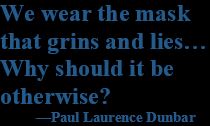 I have reached here what may be an interesting reversal of the thought expressed in the Paul Laurence Dunbar poem I began with. We see here that one wears a mask not only to hide something from the outside world, but because the outside world wants you to wear a mask so it won’t have to see what it doesn’t want to see. One might think, then, that it would be a simple thing to say we will not wear the mask, we will make you see what you don’t want to see. Indeed, there is surely a time for this. What complicates matters is that, as Baldwin says, there is a Bigger Thomas, that lives inside also, and there is no use pretending there isn’t. A racial minority in this country is compelled to live a double life, compelled to adopt an ironic attitude to the way others seem him or her. I am sure that every one wears masks of one sort or another. But no one except a racial minority is compelled to because they simply do not look so absolutely different. Because of this compulsion a version of the outside image grows also on the inside–but, as I have said, it is crucial that outside and inside remain separate. The two images meet like the two sides of a mask meet, the inside image being like the back of the mask, the one that touches the face, the outside image being the front of the mask that presents itself to the world. But they remain separate.
I have reached here what may be an interesting reversal of the thought expressed in the Paul Laurence Dunbar poem I began with. We see here that one wears a mask not only to hide something from the outside world, but because the outside world wants you to wear a mask so it won’t have to see what it doesn’t want to see. One might think, then, that it would be a simple thing to say we will not wear the mask, we will make you see what you don’t want to see. Indeed, there is surely a time for this. What complicates matters is that, as Baldwin says, there is a Bigger Thomas, that lives inside also, and there is no use pretending there isn’t. A racial minority in this country is compelled to live a double life, compelled to adopt an ironic attitude to the way others seem him or her. I am sure that every one wears masks of one sort or another. But no one except a racial minority is compelled to because they simply do not look so absolutely different. Because of this compulsion a version of the outside image grows also on the inside–but, as I have said, it is crucial that outside and inside remain separate. The two images meet like the two sides of a mask meet, the inside image being like the back of the mask, the one that touches the face, the outside image being the front of the mask that presents itself to the world. But they remain separate.
I will go to Zora Neale Hurston’s wonderful book Their Eyes Were Watching God mainly for this one scene and this one line which may help make this point about inside and outside clearer. During a particularly stressful time in her marriage, the book’s main character, Janie, is slapped by her husband Jody Starks. “Janie stood where he left her for unmeasured time and thought,” writes Hurston. “She stood there until something fell off the shelf inside her. Then she went inside there to see what it was…She had an inside and an outside now and suddenly she knew how not to mix them. (112-13)
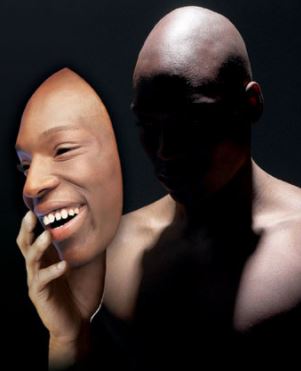 The importance of keeping inside and outside separate is spectacularly portrayed in Ralph Ellison‘s Invisible Man. In fact, the title suggests that when American society looks at a Black person they do not see that person, only its image of that person. The person needs to know that what they see is not a real self but a mask, and he or she needs to know the precise features—physical, historical, psychological—of that mask. At first the hero of the book, who is never given a name, thinks he can live without that mask, thinks others will accept him right away as a real person. This attitude causes him untold confusion, and without this mask he is continually giving up his inner complexity to an outside force which wants to make his insides as monolithic as their outside view of him is. Near the end of the book, in a eulogy to a fallen comrade, our hero says: “He was a man and a Negro; a man and a brother; a man and a traitor, as you say; then he was a dead man, and alive or dead he was jam-full of contradictions. So full that he attracted half of Harlem to come out and stand in the sun….”
The importance of keeping inside and outside separate is spectacularly portrayed in Ralph Ellison‘s Invisible Man. In fact, the title suggests that when American society looks at a Black person they do not see that person, only its image of that person. The person needs to know that what they see is not a real self but a mask, and he or she needs to know the precise features—physical, historical, psychological—of that mask. At first the hero of the book, who is never given a name, thinks he can live without that mask, thinks others will accept him right away as a real person. This attitude causes him untold confusion, and without this mask he is continually giving up his inner complexity to an outside force which wants to make his insides as monolithic as their outside view of him is. Near the end of the book, in a eulogy to a fallen comrade, our hero says: “He was a man and a Negro; a man and a brother; a man and a traitor, as you say; then he was a dead man, and alive or dead he was jam-full of contradictions. So full that he attracted half of Harlem to come out and stand in the sun….”
He finally realizes the need for something to keep inside and outside separate, and appropriately enough for my purposes today, one of the next scenes of the book he, in effect, puts on a mask and seems to see the world for the first time. Trying to escape a threatening scene he dons a white hat and shades, and is soon mistaken for a man named Rinehart. More important, it soon becomes evident that this Rinehart is many things to many people. “Could he be all of them,” says our hero: “Rine the runner and Rine the gambler and Rine the briber and Rine the lover and Rinehart the Reverend? Could he himself be both rind and heart?…His world was possibility and he knew it….”
He sees because he has donned a mask. Though I have concentrated on Baldwin’s thoughts today, he gives us only one aspect of the complex subject of mask wearing. His concern is with the delicate adjustments one must make between inside and outside images. Ellison knows there is more than one mask that you can wear, and that each mask allows you to see something different as the outside world adjusts itself to the particular face, the particular mask front, it sees. In the next chapter of Invisible Man the hero dons another mask, and amazingly enough it is the mask of an Uncle Tom, an Aunt Jemima. On his deathbed the hero’s grandfather had told his grandson:
“…after I’m gone I want you to keep up the good fight. I never told you, but our life is a war and I have been a traitor all my born days, a spy in the enemy’s country…Live with your head in the lion’s mouth. I want you to overcome ’em with yeses, undermine ’em with grins, agree ’em to death and destruction, let ’em swoller you till they vomit or bust wide open.” (16)
Our hero—everyone, in fact—thought the Grandfather had gone out of his mind, until he found out that only such masks could provide adequate protection against an overwhelmingly racist society. Another piece of advice he had been given was, “Play the game but don’t believe it.” He needed to understand how to use masks in order to accomplish this.
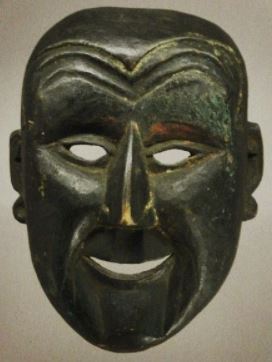 I have already quoted, near the beginning of these remarks, the passage which comes near the end of Invisible Man and contains the idea that “all life is divided and that only in division is true health.” I have been trying to say that that division is best achieved by racial minorities by the judicious, studied process of wearing masks. If nothing else, I hope that you will want to increase your familiarity with Paul Laurence Dunbar’s poetry, and with the writings of Baldwin, Hurston, and Ellison. There you may gain a more subtle, and definitely a richer feeling for the mask than I have been able to convey today. But let me in closing get out of even these great writings and share where my own thinking about masks began a few years ago.
I have already quoted, near the beginning of these remarks, the passage which comes near the end of Invisible Man and contains the idea that “all life is divided and that only in division is true health.” I have been trying to say that that division is best achieved by racial minorities by the judicious, studied process of wearing masks. If nothing else, I hope that you will want to increase your familiarity with Paul Laurence Dunbar’s poetry, and with the writings of Baldwin, Hurston, and Ellison. There you may gain a more subtle, and definitely a richer feeling for the mask than I have been able to convey today. But let me in closing get out of even these great writings and share where my own thinking about masks began a few years ago.
You might know that a college professor’s income needs lots of supplementing, and I’ve done that over the years mostly by doing lots of seminars for businesses which call me in teach writing courses or to solve this or that problem in communication or organization. At one of these seminars, for one of the country’s largest engineering firms, it so happened that six of the twenty students were, like me, Filipinos, and during the breaks we would talk, working on the old affiliations that always seem to arise when people from the Philippines recognize one another. I suppose it’s the same for other ethnic groups. I felt comfortable with them in class, and I could tell they were proud for one of their countrymen to be teaching the whole group English. That’s always a sore point for Filipinos. We know English. The first time my first father-in-law met my mother he asked her—mostly through innocence—whether she spoke English, thinking, I suppose, that that might be the source of the marked shyness my mother always showed in the face of the dominant society. She and my father were so incensed that they wanted me to break off relations with this American girl I was dating. You see, my mother had taught English in a Philippine normal school for ten years. And I, too, have come under similar suspicion. At my own church, where I am song and worship leader, not too many years ago a newcomer, when directed to speak to me about this or that, asked her friend, “Does he speak English?” I suppose seeing me lead the singing and the worship hadn’t convinced her that I did indeed know the language. As I have said, the dominant society creates images of you which seem to simply blind them to reality.
At any rate, getting back to this one particular seminar, during one of the breaks during the third or fourth class session, one of my countrymen got me away and said, “Can you teach me to do what you do?” “What’s that?” I asked. “Well, when you’re speaking with us during the breaks, your English sounds like ours, but the minute you step in front of the whole group it changes just like that,” he said with a sharp snap of his fingers. “It’s all white!” Admiration filled his voice. I recovered quickly, and I said to him, “Art—his name was Art Baizas—I paid a big price to be able to do that. I don’t know if you want to pay that much—or should.”
That price was becoming correspondingly estranged from my own people to the degree that I conformed so well to the image of the dominant culture. Once people got used to hearing my virtually accentless speech, they came to forget my color. But so did I. It was not so much that they accepted my difference, but that they and I forgot it, and thereby lost touch with a basic reality. Much of this is merely personal, but a lot of it isn’t.
Filipinos in particular may of all racial groups find themselves at the opposite end of the spectrum from African-Americans simply because our country has been ruled by Westernpowers—mainly Spain and the United States—for almost four centuries. We have steeped ourselves as a people in United States idealism for years, so much so that many of our writers have often wondered whether we are really different at all. In the December 1940 issue of Philippine-American News Digest, the journalist P.C. Morante wrote:
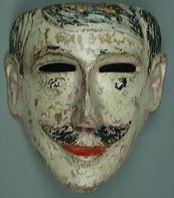 “In myself I am often at a loss to account for the genuine native. To be sure, I have the physical quality of my race; but I feel that the composition of my soul is thoroughly soaked with the alien spirit. Of course…a great number okf my people…are aware that even their virtues are borrowed and that their thinking, their dreams and their aspirations have been influenced so much by American and Spanish ways that the indigenuos substance of their true being has been crushed or lost…My actions and reasctions, my thoughts and ideals, even my complexes and inhibitions—all this seems to revolve around a foreign pattern that is easily recognizable as intrinsically of the West.”
“In myself I am often at a loss to account for the genuine native. To be sure, I have the physical quality of my race; but I feel that the composition of my soul is thoroughly soaked with the alien spirit. Of course…a great number okf my people…are aware that even their virtues are borrowed and that their thinking, their dreams and their aspirations have been influenced so much by American and Spanish ways that the indigenuos substance of their true being has been crushed or lost…My actions and reasctions, my thoughts and ideals, even my complexes and inhibitions—all this seems to revolve around a foreign pattern that is easily recognizable as intrinsically of the West.”
But just let an incident happen like the one I told you about at my church. And just think what a white person probably thinks seeing me walk down the street. My skin marks me as foreign. My foreigness calls into question my English, for example, and I can no longer deny my “place.” I love my difference, but hate it also. Under such circumstances I think I better try to understand mask wearing better.
In the beginning of my remarks I said I was preaching deception, but perhaps I said that merely to be provocative. My Hopi Indian friend Ramson Lomatewama told me yesterday that the Hopi do not call masks “masks.” The Hopi refer to them as “friends.” As “friends” they protect the inside, on the one hand, and allow powerful visions of the outside world on the other. The mask as friend. Perhaps this is a better idea to end on. And if we cannot see some masks as friends, perhaps this idea might at least lead us to make peace with them and, to use Baldwin’s phrasing, learn to exploit them in the most honorable way. Such a way might lead us all to become more sensitive to masks and to study them as a way of acquiring a more precise understanding of our differences and thereby appreciating our diversity more than ever.
END of PART 2, RETURN to PART 1
♦ Go to the Teaching Diversity page, to a List of Black Writers written about on this site, as well as a post listing all the writing specifically on James Baldwin.
